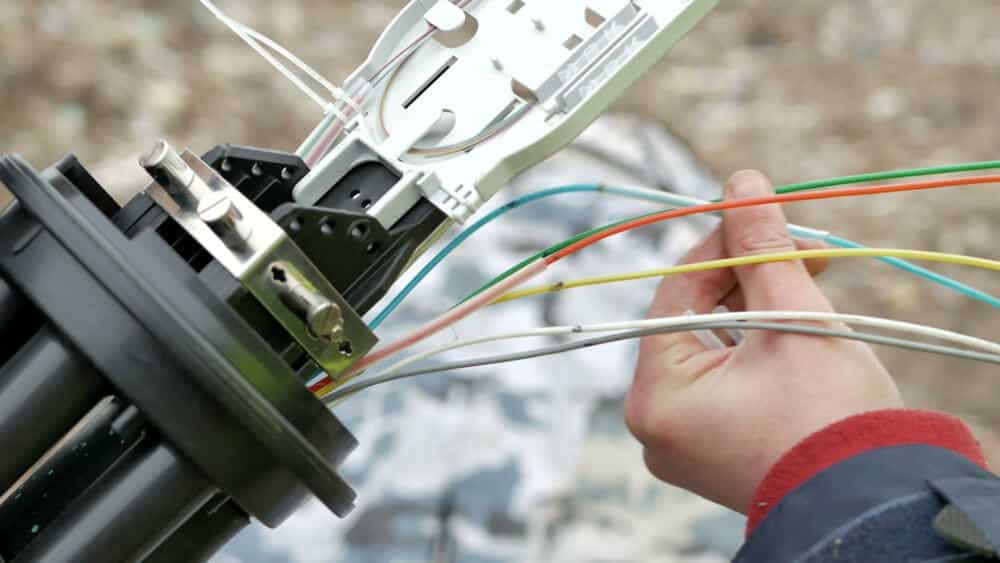
In today’s world, you can’t get far without a solid internet connection. The internet connects us to information, socialization, business operations, and more. Businesses across the country are discovering the benefits of SD-WAN services, Contact Center as a Service (CCaaS), and fast internet.
There are many ways faster internet enhances business operations, including higher productivity levels, robust security, and efficient cloud access. There are two primary types of internet: cable and fiber. Let’s take a look at the differences and similarities of cable internet vs. fiber internet and narrow down which type is best for your business.
What Is Cable Internet?
Cable internet is also referred to as broadband internet. Cable internet is quite literally delivered using cables. The same copper coaxial cables that provide cable television also deliver cable internet. A coax cable can supply internet and television connections at the same time. The wires are comprised of:
- A copper core
- An insulating sheath
- Copper and aluminum shields
- A plastic outer layer
Typically, a cable internet modem delivers internet, but neighborhoods and areas connect each network. Connections from different households, offices, or businesses converge together, often on a utility pole on the street, and they share bandwidth.
How Fast Is Cable Internet?
Cable network speed can usually accommodate large downloads. However, since the network is connected and shared by neighborhoods, slow speeds often occur during high usage times. If your business is located in a highly populated area, you may experience dramatic slowdowns during peak business hours when you need to be productive.
Cable download speeds range from 10 to 500 megabits per second (Mbps). The upload speed range is 5 to 50 Mbps. You select your preferred speed when you sign up for cable internet. The higher the speed, the more money you pay. Even still, the speed you pay for isn’t guaranteed. Many cable service providers have data caps, and if you go over the data limit, you may need to pay additional fees.
Cable Network Availability
Cable networks are available just about everywhere across the country. If you live in an area where you can access a television network, you can also access cable internet. Cable internet is available in all 50 states and has 89% coverage across the United States. Cable internet availability is higher in urban areas compared to rural areas.
Cable Reliability
For the most part, cable internet for business is very reliable. However, electricity outages can affect cable connection. Cable internet is not as reliable in areas with frequent electricity outages and cable interruptions. Backup internet sources may be needed during power outages. Even still, cable internet is more reliable than other internet sources such as digital subscriber lines (DSL) or satellites.

What Is Fiber Optic Internet?
Now that you have an understanding of cable internet, let’s explore the offerings of fiber internet. While cable internet uses copper cables, fiber internet uses fiber optic cables to deliver internet to homes and businesses. Fiber optic cables are comprised of optical fibers, which are incredibly thin strands of glass or plastic.
Fiber utilizes LED or laser pulses to transfer internet data over long distances. Fiber cables carry more bandwidth than copper cables, which makes fiber internet a popular choice. Fiber internet technology is newer, so it is not as widely used as cable internet.
How Fast Is Fiber Internet?
Fiber internet is the fastest internet available today. Fiber cables can transfer large amounts of data without delays in processing. Additionally, fiber optic internet does not have bandwidth caps, so you can use as much as you need.
Fiber internet does not share networks, so peak-time lags are not an issue as with cable internet. High-speed business fiber internet help improves productivity and customer satisfaction. Fiber speeds for uploading and downloading are no less than 250 to 1,000 Mbps, which is significantly faster than traditional broadband internet.
Fiber Network Availability
Fiber internet is still in an expansion stage, so connections are not as easily accessible as cable internet. However, as fiber internet gains popularity, it is becoming more available. Fiber optic internet would be more difficult for rural businesses to obtain, but it is more accessible in metropolitan areas.
Fiber Reliability
Fiber internet is incredibly reliable. Electricity disruptions do not affect fiber network availability, so internet connections continue if the electricity goes down. This reliability is because fiber optic cables are made of glass, and they do not conduct electricity.
It is incredibly rare for a fiber network to get interrupted. This consistent network reliability makes a considerable difference in productivity for businesses when they need it most.
The Best Choice for Businesses
Fiber internet is the most efficient choice for businesses in metropolitan areas with access to fiber. Fiber internet boasts the fastest speeds, large bandwidth capacities, and network reliability unimpacted by power outages. Companies with high productivity demands will find that fiber internet best suits their needs.
For rural companies or businesses with less demanding needs, cable internet is suitable. If businesses don’t have many content needs, mission-critical internet applications, or on-location servers, cable internet can adequately meet their needs while saving a little bit of money.
Are You Ready to Upgrade Your Internet?
Even though cable and fiber internet have many similarities, they also have differences that distinguish them from each other. Gone are the days of satellite and dial-up internet connections. At a minimum, businesses need cable internet to operate. However, the best way to improve speed, productivity, and reliability is by installing fiber internet.
Are you curious to know if fiber internet is right for your business? Integrated Communications can help. We will perform a free telecommunications and networking audit for your business. Don’t wait any longer to determine how your business can improve user experience, save money, and increase productivity; instead, contact us today!
